Carbon and mineral transformations in seafloor serpentinization systems
Author(s)
Grozeva, Niya G
DownloadFull printable version (16.96Mb)
Other Contributors
Woods Hole Oceanographic Institution.
Advisor
Frieder Klein and Jeffrey S. Seewald.
Terms of use
Metadata
Show full item recordAbstract
This thesis examines abiotic processes controlling the transformation and distribution of carbon compounds in seafloor hydrothermal systems hosted in ultramafic rock. These processes have a direct impact on carbon budgets in the oceanic lithosphere and on the sustenance of microorganisms inhabiting hydrothermal vent ecosystems. Where mantle peridotite interacts with carbon-bearing aqueous fluids in the subseafloor, dissolved inorganic carbon can precipitate as carbonate minerals or undergo reduction by H2(aq) to form reduced carbon species. In Chapters 2 and 3, I conduct laboratory experiments to assess the relative extents of carbonate formation and CO2 reduction during alteration of peridotite by C02(aq)-rich fluids. Results from these experiments reveal that formation of carbonate minerals is favorable on laboratory timescales, even at high H2(aq) concentrations generated by serpentinization reactions. Although CO2(aq) attains rapid metastable equilibrium with formate, formation of thermodynamically stable CH4(aq) is kinetically limited on timescales relevant for active fluid circulation in the subseafloor. It has been proposed that CH4 and potentially longer-chain hydrocarbons may be sourced, instead, from fluid inclusions hosted in plutonic and mantle rocks. Chapter 4 analyzes CH4-rich fluid inclusions in olivine-rich basement rocks from the Von Damm hydrothermal field and the Zambales ophiolite to better understand the origin of abiotic hydrocarbons in ultramaficinfluenced hydrothermal systems. Comparisons of hydrocarbon abundances and stable isotopic compositions in fluid inclusions and associated vent fluids suggest that fluid inclusions may provide a significant contribution of abiotic hydrocarbons to both submarine and continental serpentinization systems.
Description
Thesis: Ph. D., Joint Program in Oceanography/Applied Ocean Science and Engineering (Massachusetts Institute of Technology, Department of Earth, Atmospheric, and Planetary Sciences; and the Woods Hole Oceanographic Institution), 2018. Cataloged from PDF version of thesis. Includes bibliographical references.
Date issued
2018Department
Joint Program in Oceanography/Applied Ocean Science and Engineering; Woods Hole Oceanographic Institution; Massachusetts Institute of Technology. Department of Earth, Atmospheric, and Planetary SciencesPublisher
Massachusetts Institute of Technology
Keywords
Joint Program in Oceanography/Applied Ocean Science and Engineering., Earth, Atmospheric, and Planetary Sciences., Woods Hole Oceanographic Institution.